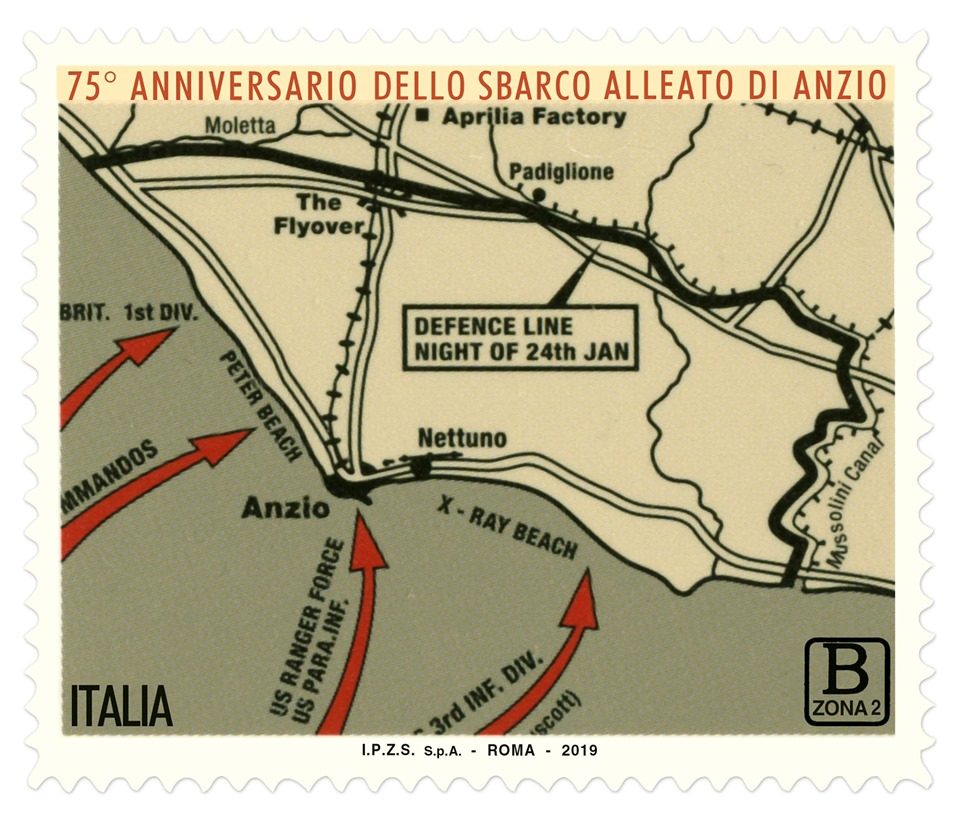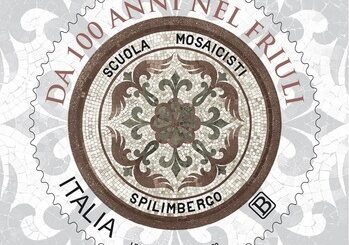POSTE ITALIANE 34^ emissione del 22 giugno 2019 di un francobollo celebrativo del 75° anniversario dello Sbarco Alleato di Anzio.
POSTE ITALIANE 34^ emissione del 22 giugno 2019 di un francobollo celebrativo del 75° anniversario dello Sbarco Alleato di Anzio.

Il Ministero dello Sviluppo ha emesso il 22 giugno 2019 un francobollo celebrativo del 75° anniversario dello Sbarco Alleato di Anzio, relativo al valore della tariffa B zona 2, corrispondente ad €2,40.
- data / date 22 giugno 2019
- dentellatura / serration 11
- stampa / printing fustellatura/rotocalco
- tipo di carta / paper type bianca patinata neutra
- stampato / printed I.P.Z.S. Roma
- tiratura / edition 300.000
- fogli / sheet 28
- dimensioni / dimension 48 x 40 mm
- costo / price B2= €2.40
- bozzettista/ designer
- num. catalogo Mi 4131 YT 3892 UN 3974
Sbarco di Anzio
Lo sbarco di Anzio (nome in codice operazione Shingle) fu un’operazione militare di sbarco anfibio, condotta dagli Alleati sulla costa tirrenica antistante gli abitati di Anzio e Nettuno, durante la campagna d’Italia nella seconda guerra mondiale. L’obiettivo di tale manovra era la creazione di una testa di ponte ad Anzio oltre lo schieramento tedesco sulla linea Gustav, in modo tale da aggirarla e costringere gli avversari a distogliere ingenti forze dal fronte di Cassino, permettendo così lo sfondamento della 5ª Armata del generale Mark Clark lungo il settore tirrenico della Gustav. In contemporanea, le truppe sbarcate ad Anzio avrebbero occupato i colli Albani, impedendo la ritirata delle divisioni tedesche: la loro distruzione avrebbe consentito di conquistare Roma e abbreviare la campagna.
Lo sbarco avvenne con successo il 22 gennaio 1944 a opera del VI Corpo d’armata statunitense, guidato dal maggior generale John Lucas; ma nel suo complesso l’operazione Shingle non raggiunse gli obiettivi iniziali prefissati. Le forze tedesche sotto il comando del feldmaresciallo Albert Kesselring, nonostante la sorpresa iniziale, riuscirono a bloccare l’iniziale avanzata del VI Corpo d’armata e a sferrare una serie di contrattacchi, che misero in seria difficoltà gli anglo-americani e costarono loro forti perdite. La lunga e logorante battaglia di posizione che seguì nell’area della testa di ponte continuò fino alla primavera successiva, quando i tedeschi furono costretti alla ritirata dopo il crollo del fronte di Cassino. Anche in questo caso, però, l’obiettivo principale, ossia la distruzione delle forze tedesche in Italia, non fu conseguito e i tedeschi in ritirata poterono sfuggire dalla morsa nemica e ridisporsi sulla Linea Gotica, baluardo che bloccò per mesi gli anglo-americani sugli Appennini.
Se sei interessato all’acquisto del francobollo lo puoi acquistare al prezzo di € 3.00. Inviami una richiesta alla email: protofilia1@gmail.com

POSTE ITALIANE 34th issue of 22 June 2019 of a stamp celebrating the 75th anniversary of the Allied Landing of Anzio.
On June 22, 2019, the Ministry of Development issued a stamp celebrating the 75th anniversary of the Allied Landing at Anzio, relating to the value of tariff B zone 2, corresponding to € 2.40.
Landing of Anzio
The landing of Anzio (code-named operation Shingle) was a military operation of amphibious landing, conducted by the Allies on the Tyrrhenian coast in front of the towns of Anzio and Nettuno, during the Italian campaign in the Second World War. The objective of this maneuver was the creation of a bridgehead at Anzio beyond the German line-up on the Gustav line, in such a way as to circumvent it and force opponents to divert huge forces from the Cassino front, thus allowing the breakthrough of the 5th Army of the General Mark Clark along the Gustav Tyrrhenian sector. At the same time, the troops landed at Anzio would have occupied the Alban hills, preventing the retreat of the German divisions: their destruction would have allowed Rome to be conquered and the countryside shortened.
The landing took place successfully on January 22nd 1944 by the VI US Army Corps, led by Major General John Lucas; but as a whole the Shingle operation did not achieve the initial goals set. The German forces under the command of Field Marshal Albert Kesselring, despite the initial surprise, managed to block the initial advance of the VI Corps and launch a series of counterattacks, which put Anglo-Americans in serious trouble and cost them heavy losses . The long and exhausting battle of position that followed in the area of the bridgehead continued until the following spring, when the Germans were forced to retreat after the collapse of the Cassino front. Even in this case, however, the main objective, namely the destruction of the German forces in Italy, was not achieved and the retreating Germans could escape from the enemy grip and rearrange themselves on the Gothic Line, a bulwark that blocked the Anglo-Americans in the Apennines for months .

If you are interested in buying the stamp you can buy it for € 3.00. Send me a request to the email: protofilia1@gmail.com
- data / date 22 giugno 2019
- dentellatura / serration 11
- stampa / printing fustellatura/rotocalco
- tipo di carta / paper type bianca patinata neutra
- stampato / printed I.P.Z.S. Roma
- tiratura / edition 300.000
- fogli / sheet 28
- dimensioni / dimension 48 x 40 mm
- costo / price B2= €2.40
- bozzettista/ designer
- num. catalogo Mi 4131 YT 3892 UN 3974






